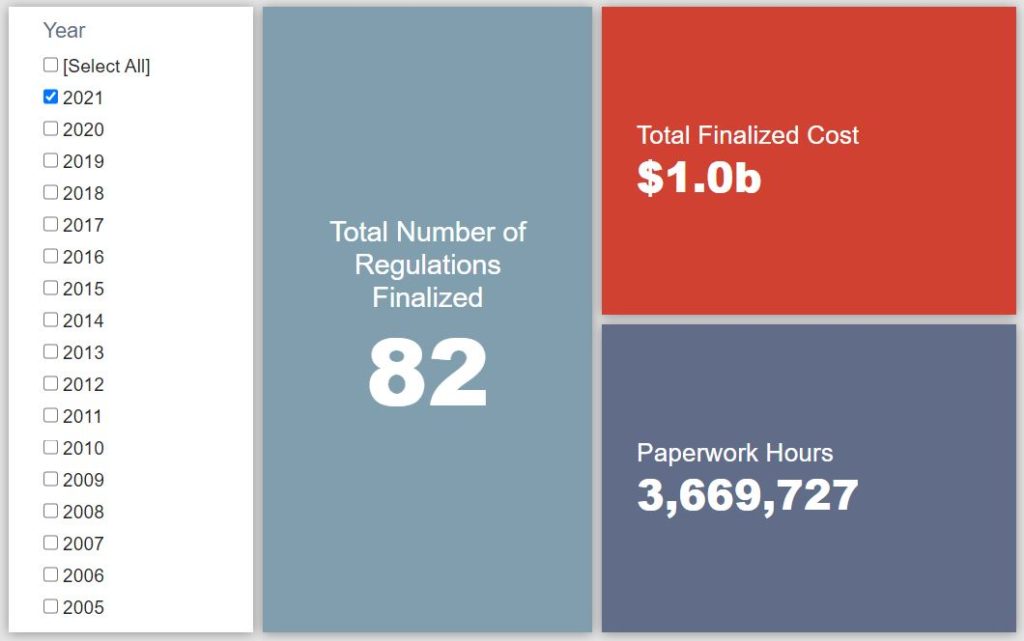Week in Regulation
April 19, 2021
A Proposed Paperwork Cut and Not Much Else
In what is becoming an increasingly fascinating trend, last week saw very little in the way of significant rulemaking activity. The prior few weeks have been incredibly barren. At least this week has the distinction of a modest cost-cutting measure, albeit one included in an otherwise routine type of rulemaking. Across all rulemakings, agencies published $41.6 million in total net cost savings and cut 734,964 annual paperwork burden hours.
REGULATORY TOPLINES
- Proposed Rules: 49
- Final Rules: 29
- 2021 Total Pages: 20,215
- 2021 Final Rule Costs: $1 Billion
- 2021 Proposed Rule Costs: -$8.3 billion
NOTABLE REGULATORY ACTIONS
The most noteworthy rulemaking of the week was the Department of Health and Human Services (HHS) proposed version of its “Inpatient Psychiatric Facilities Prospective Payment System and Quality Reporting Updates for Fiscal Year Beginning October 1, 2021 (FY 2022).” The proposal is one of various rulemakings HHS promulgates each year in its administration of the Medicare and Medicaid programs. Most largely focus upon readjusting the transfers payments flowing through said programs. Occasionally, such as in this instance, there are changes to the administrative burdens involved. This proposal reduces specific Inpatient Psychiatric Facilities Quality Reporting requirements in such a way that cuts approximately 785,000 annual paperwork burden hours. This yields nearly $21 million in annual cost savings, or roughly $63 million over the three-year course of the paperwork requirements in question.
CONGRESSIONAL REVIEW ACT UPDATE
On March 23, the first joint resolution of disapproval under the Congressional Review Act (CRA) of this term was introduced. CRA resolutions essentially seek to wholly rescind specific final rules within a set timeframe. The significance of these resolutions is discussed further here. In the interest of providing a public accounting of the potential economic impact of these actions should they pass, the American Action Forum (AAF) will provide a regular update of the rules being targeted and a concise summary of each rule’s purpose, economic impact, and why opponents may be targeting it.
TRACKING THE ADMINISTRATIONS
As we have already seen from executive orders and memos, the Biden Administration will surely provide plenty of contrasts with the Trump Administration on the regulatory front. And while there is a general expectation that the new administration will seek to broadly restore Obama-esque regulatory actions, there will also be areas where it charts its own course. Since the AAF RegRodeo data extend back to 2005, it is possible to provide weekly updates on how the top-level trends of President Biden’s regulatory record track with those of his two most recent predecessors. The following table provides the cumulative totals of final rules containing some quantified economic impact from each administration through this point in their respective terms.
![]()
With the only notable rulemaking of the week coming in the form of a proposed rule, the stagnation in final rule activity thus far into the Biden era continues. Compared to some of AAF’s most recent updates, however, this past week was not terribly out of line with commensurate time windows in the Trump and Obama Administrations. The only real divergence came during the Obama era when there was a roughly $160 million uptick in costs, due largely to this Nuclear Regulatory Commission rule.
THIS WEEK’S REGULATORY PICTURE
This week, the Council on Environmental Equality (CEQ) rescinds its Trump-era rule on guidance documents.

On April 13, the CEQ became the latest federal agency to publish a federal register notice rescinding its rule on guidance documents. The rule, which was promulgated under President Trump’s Executive Order (EO) 13,891 aimed at improving the transparency of agency guidance documents, was rescinded pursuant to President Biden’s EO 13,992, which revoked the Trump Administration’s order.
The Trump Administration’s order directed agencies to develop rules for issuing guidance documents. These rules had to allow for public notice before many guidance documents could take effect and for all active guidance documents to be posted on a single page on their website so the public could easily find them.
The Biden Administration revoked this EO on its first day in office, along with a bevy of other EOs, citing the need to remove agency procedures that it claimed would slow the federal government’s ability to respond to the COVID-19 pandemic, and other challenges such as climate change and systemic racism.
In revoking its rule, CEQ echoed these criticisms of the Trump requirements, claiming that they were “harmful policies” that “threaten to frustrate” the federal government’s ability to respond. It bypassed notice and comment on the rule since it is a rule of an agency’s internal organization or procedures.
CEQ became the fifth agency to issue a final rule rescinding its guidance rule, joining the Agency for International Development, Pension Benefit Guaranty Corporation, and the Departments of Transportation and Labor. By the end of the week, the Department of the Interior became the sixth member of the list. According to the Competitive Enterprise Institute, 32 agencies had issued rules to comply with the Trump order by the end of that administration.
TOTAL BURDENS
Since January 1, the federal government has published $7.3 billion in total net cost savings (with $1 billion in new costs from finalized rules) and 8 million hours of net annual paperwork burden reductions (with 3.7 million hours in increases from final rules).












